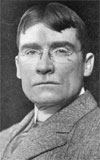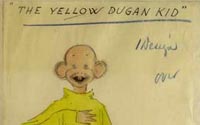It’s a little-recognized, never-celebrated anniversary in American journalism, granted.
But today marks the 113th year since the term “yellow journalism” first appeared in print, in the New York Press, edited by the austere Ervin Wardman.
The phrase “the Yellow Journalism” appeared in a small headline on the Press’ editorial page on January 31, 1897. The phrase also appeared that day in the Press’ editorial page gossip column, “On the Tip of the Tongue.”
“Yellow journalism” caught on quickly, as a way to denigrate what then was called the “new journalism” of William Randolph Hearst’s New York Journal and of Joseph Pulitzer‘s New York World. By the end of March 1897, references to “yellow journalism” had appeared in newspapers in Providence, Richmond, and San Francisco.
In the decades since then, “yellow journalism” has become a widely popular sneer, a derisive shorthand for denouncing sensationalism and journalistic misconduct of all kinds, real and imagined. “It is,” as I noted in my 2001 book Yellow Journalism: Puncturing the Myths, Defining the Legacies, “an evocative term that has been diffused internationally, in contexts as diverse as Greece and Nigeria, as Israel and India.”
Precisely how Wardman and the Press landed on the phrase “yellow journalism” is not clear.
The newspaper’s own, brief discussion of the origins was vague and unrevealing: “We called them Yellow because they are Yellow,” it said in 1898 about the Journal and the World.
In the 1890s, the color yellow sometimes was associated with depraved literature, which may have been an inspiration to the Harvard-educated Wardman, a figure largely lost to New York newspaper history.
Wardman was tall and stern-looking. He once was described as showing his “Calvinistic ancestry in every line of his face.” He did little to conceal his disdain for Hearst and Hearst’s journalism.
His contempt was readily apparent in the columns of the Press, of which Wardman became editor in chief in 1896 at the age of 31. (The Press is long defunct; it is not to be confused with the contemporary alternative weekly by the same name.)
Wardman’s Press took to taunting Hearst, Hearst’s mother, and Hearst’s support for Democratic candidate William Jennings Bryan in the 1896 presidential election. Hearst’s Journal was virtually alone among New York newspapers in supporting Bryan’s “free silver” candidacy.
The Press disparaged Hearst, then 34, as a mama’s boy, as “Billy” and “little Willie.” It referred to the Journal as “our silverite, or silver-wrong, contemporary.”
The Press also experimented with pithy if stilted turns of phrase to denounce “new journalism.”
“The ‘new journalism,’” the Press said in early January 1897 “continues to think up a varied assortment of new lies.”
Later in the month, the Press asked in a single-line editorial comment:
“Why not call it nude journalism?”
It clearly was a play on “new journalism” and meant to suggest the absence of “even the veneer of decency.”
Before long, Wardman and the Press seized upon the phrase “yellow-kid journalism,” which evoked the Hearst-Pulitzer rivalry over a popular cartoon character known as the “Yellow Kid.” Both the Journal and the World at the time were publishing versions of the kid.
At the end of January 1897, the phrase “yellow-kid journalism” was modified to “the Yellow Journalism,” and the sneer was born.
After landing on that sneering pejorative, Wardman turned to it often, invoking the term in brief editorial comments and asides such as: “The Yellow Journalism is now so overripe that the little insects which light upon it quickly turn yellow, too.”
The diffusion of “yellow journalism” was sealed when Hearst’s Journal embraced the term in mid-May 1898, during the Spanish-American War. With typical immodesty, it declared:
“… the sun in heaven is yellow—the sun which is to this earth what the Journal is to American journalism.”



[…] journalism” is a delicious and versatile sneer, a term that first appeared in print in late January 1897 and routinely invoked in the decades […]
[…] evocative sneer “yellow journalism” first appeared in print in […]
[…] way to call attention to the Times in New York’s crowded newspaper market—one dominated by the yellow journalism of William Randolph Hearst and Joseph Pulitzer. Ochs had acquired the beleaguered Times in August […]
[…] was just such a case: For Hearst’s Journal, the leading exemplar of flamboyant “yellow journalism,” her rescue was “epochal,” a “supreme achievement of the journalism of action.” […]
[…] That notion, I wrote in my 2001 book, Yellow Journalism: Puncturing the Myths, Defining the Legacies, “tidily, if mistakenly, serves to illustrate the power and the lurking malevolence of America’s news media.” That’s an important reason the yellow journalism myth lives on. […]
[…] is, quite simply, little evidence to support such a claim. (And coining the term “yellow journalism” predated the Maine’s destruction by more than a […]
[…] as heir to yellow journalism, as it was practiced in urban America at the end of the 19th century and early 20th […]
[…] sections of the book about the yellow press period at the end of the 19th century, Thomas ignored–or was unaware of–recent scholarship […]
[…] Yellow journalism: A sneer is born […]
[…] of the more hearty, adaptable, and internationally appealing media myths is that of American “yellow journalism,” and how its sensational and exaggerated content supposedly brought about the […]
[…] is, after all, far easier to believe that Hearst and his “yellow press” brought on the Spanish-American War in 1898, I said, than it is to grasp the complexities of […]
[…] among Spain, Cuba, and the United States: Failed diplomacy, not the contents of Hearst’s yellow press, led to the Spanish-American […]
[…] commentary assails conservative publisher Andrew Breitbart as a latter-day practitioner of “yellow journalism” and invokes what are media myths in making that […]
[…] I discuss in Yellow Journalism, the epithet was devised in early 1897 to impugn the journalism of both Pulitzer and […]
[…] It says the Spanish-American War–which was fought over Cuba in 1898–”was a conflict sold to the American public by New York newspaper publishers including Joseph Pulitzer and William Randolph Hearst,” the city’s leading practitioners of yellow journalism. […]
[…] ever-appealing and often-invoked epithet “yellow journalism” dates after all to 1897–and the efforts of a New York newspaper editor to find a pithy […]
[…] offers a simplistic explanation for a complex subject. It is far easier to blame Hearst’s yellow press for fomenting the conflict than it is to sort through the failed diplomacy that led the United […]
[…] The jailbreak was breathtakingly illegal–and one of the most astonishing episodes in American journalism. The Journal declared it “epochal,” a stunning success of its activist brand of yellow journalism. […]
[…] eager–to comment on, and disparage, the content of their rivals. That’s how the enduring sneer “yellow journalism” was coined, in early […]
[…] and activist-oriented New York Journal — the newspaper that helped give rise in 1897 to the sneer, “yellow […]
[…] scoffed and sneered; “yellow journalism” they called […]
[…] Yellow journalism: A sneer is born […]
[…] impressively dexterous term emerged in early 1897. That was when a New York newspaper editor named Ervin Wardman coined “yellow […]
[…] that of “yellow journalism.” Wardman, father to a […]
[…] an essay originally posted at Media Myth Alert January 31, […]
[…] Ochs was nothing if not aggressive in promoting the Times and in seeking to position the newspaper as a sober counterweight to the activism and excesses of the yellow press. […]
[…] NYTimes practices ‘yellow journalism’? How so? […]
[…] a misreading of history, a lazy interpretation that ascribes too much power to Hearst and his yellow press while ignoring the human rights disaster on Cuba that helped precipitate the war in April […]
[…] Yellow journalism: A sneer is born […]
[…] claims about William Randolph Hearst, Joseph Pulitzer, and the war-mongering ways of their yellow newspapers. The claims are readily offered but rarely […]
[…] Yellow journalism: A sneer is born […]
[…] my 2001 book, Yellow Journalism: Puncturing the Myths, Defining the Legacies, critics who blame the yellow press of Hearst (and his rival, Joseph Pulitzer) for bringing on the war invariably fail to explain how […]
[…] book, Muzzled: The Assault on Honest Debate, repeats the hoary media myth that the yellow press of William Randolph Hearst and Joseph Pulitzer brought on the Spanish-American War of […]
[…] Yellow journalism: A sneer is born […]
[…] Yellow journalism: A sneer is born […]
[…] At the end of January 1897, the phrase “yellow-kid journalism” was modified to “the Yellow Journalism,” and the sneer was born. […]
[…] Yellow journalism: A sneer is born […]
[…] Yellow journalism: A sneer is born […]
[…] yellow press of Hearst and Pulitzer certainly reported closely about the Spanish-American War of 1898. But no […]
[…] the “furnish the war” vow was suggestive of the aggressive, anticipatory “yellow journalism” that he saw and liked in Hearst’s […]
[…] of telegrams, invoking it to praise the aggressive, anticipatory character of Hearst’s “yellow journalism.” Only years later did Creelman’s unsourced anecdote become popular as evidence of […]
[…] Yellow journalism: A sneer is born […]
[…] that matter, “yellow journalism” was left […]
[…] Yellow journalism: A sneer is born […]
[…] At the end of January 1897, “yellow-kid journalism” was modified to “the Yellow Journalism,” and the sneer was born. […]
[…] Yellow Journalism: A sneer is born […]
[…] yellow kid character was a contributing factor in the naming of “yellow journalism.” But not the sole […]